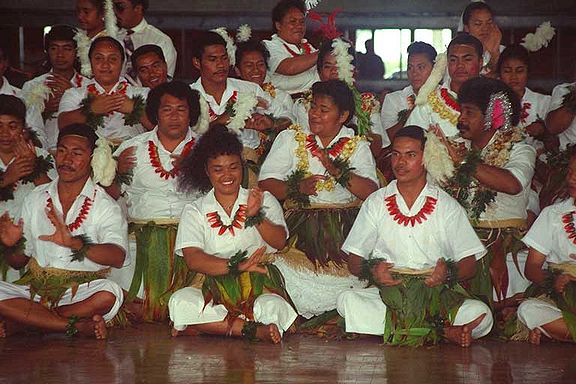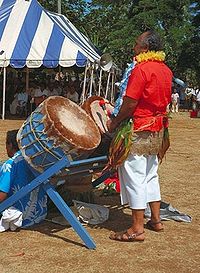
Ma'ulu'ulu
Encyclopedia

Tonga
Tonga, officially the Kingdom of Tonga , is a state and an archipelago in the South Pacific Ocean, comprising 176 islands scattered over of ocean in the South Pacific...
n dance
Dance
Dance is an art form that generally refers to movement of the body, usually rhythmic and to music, used as a form of expression, social interaction or presented in a spiritual or performance setting....
, performed by a group of seated men and women; stylistically, the dance form is a direct successor of the ancient Tongan otuhaka
'otuhaka
right|300pxThe otuhaka is a traditional Tongan group dance with prominent Sāmoan influence wherein the performers are seated and make gestures with their arms only, with some accentuation from head and body....
having been synthesized with the Samoan Māuluulu
Maulu'ulu
The Maulu'ulu is an indigenous dance to the Samoan people, performed by a group of girls standing, it requires perfect co-ordination and the girls must smile at all times. The Maulu'ulu was another form of dance that was taken to Kingdom of Tonga from Samoa by the royal family, along with the...
which was imported during the 19th century.
The performers sit down in a row on the ground, crosslegged, usually the right leg over the left. If possible men and women alternate. To the left and/or right is/are the nafa (see below), behind them stand the langitua, the singers. On informal occasions the dancemaster may walk around, clapping his hands to keep up the rhythm and to encourage the performers. On formal occasions, like a presentation to the king, the dancemaster also stands in the back. Only when the dancemaster is the chief Malukava, he is allowed per tradition to be in front.
If there are many dancers, often the case when a school performs, up to 500 at a really huge occasion, they sit in staggered rows. The dancers of front row (which gets the most attention and therefore sits the best dancers or the ones with the highest social status) sit on the ground. The second row on a low bench, the next row on a higher bench, and so forth. The last row usually stands, or if that is still not enough, they may stand on benches and tables. If the dance is an effort of a local community, young and old perform. The youngest children then cutely sit at the ends of the rows.
In the Uiha
'Uiha
Uiha is an island in Lifuka district, in the Haapai islands of Tonga. It had a population of 638 and an area of 5.36 km².More about Ha'apai at http://www.nelligennet.com/horst.com...
tradition the arrangement is different: the women sit on the ground in the frontrow(s) but the men stand behind them and act more as in a lakalaka
Lakalaka
The lakalaka is a Tongan group dance where the performers are largely standing still and make gestures with their arms only. It is considered as the national dance of Tonga and part of the intangible human heritage...
.

When the tafua is over the nafa usually stops and singing starts. Like all other Tonga dances, the gestures do have some relationship with the words, but are largely symbolic. Like in the otuhaka the haka are supposed to be performed close the body, haka nounou (short armed) as opposed to the lakalaka
Lakalaka
The lakalaka is a Tongan group dance where the performers are largely standing still and make gestures with their arms only. It is considered as the national dance of Tonga and part of the intangible human heritage...
. However the Vavau
Vava'u
Vavau is an island chain of one large island and 40 smaller ones in Tonga. According to tradition Maui fished both Tongatapu and Vavau but put a little more effort into the former. Vavau rises 204 meters above sea level...
tradition allows much wilder and wider arm movements. The lyrics of the song is usually made for the occasion, praising the object into the skies. A silver jubilee of a school, a birthday of the king, and so on. The music is very limited. There are about 10 different tunes which can be used in a māuluulu, so that to the untrained ear they all sound much alike.
Once the song is over another tafua follows. At this time the tempo of the dance has been increased feverishly, and so has the excitement of the public.
A māuluulu takes around 15 minutes to complete. But it may have taken the performers 2 or 3 months to memorise the sequence of gestures. For a school there are daily sessions at the end of the class hours, for a community it will fill all their free nights, often combined with a faikava
Kava culture
Kava cultures are the religious and cultural traditions of western Oceania which consume kava. There are similarities in the use of kava between the different cultures, but each one also has its own traditions.-Hawaii:...
.

